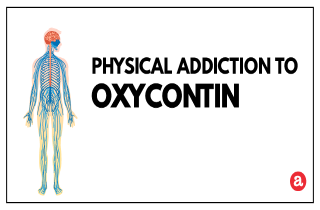Dependence and addiction are not the same
Are you experiencing symptoms of physical addiction to OxyContin? Wondering how this condition can be managed? Learn more about how you can recognize the signs of physical addiction to OxyContin. Then, we outline your alternatives for getting help. At the end we welcome you to post your questions and we’ll try to respond personally and promptly to all legitimate enquiries.
Physical dependence on OxyContin
According to the National Institute of Drug Abuse (NIDA) physical dependence is a normal adaptation that follows a chronic exposure to OxyContin and is not the same as addiction. A physically dependent person has adapted to the presence of OxyContin in their system and requires regular doses to avoid withdrawal. Withdrawal symptoms are felt when doses of OxyContin are suddenly discontinued or significantly lowered. These symptoms include worsening of pain, sleeping and eating disorders as well as other metabolic abnormalities.
Further, an individual who is physically dependent on OxyContin, may also experience an increased level of tolerance to the medication. When you become tolerant, you need more medicine to achieve initial effect.
OxyContin addiction, on the other hand, is mainly psychological in nature. People who experience addiction repeatedly take OxyContin, regardless of the negative consequences to health, home, or workl. Chronic addicts also experience changes in the structure and function of the brain, and start to seek the medication compulsively.
While dependence on OxyContin is an expected and natural occurrence when using a medication such as OxyContin for a period of time, addiction usually has a more deeply rooted psychological background. People addicted to OxyContin experience excessive stimulation of the reward pathway. The drug works by tricking the brain to believe that using is equally essential for survival as food and water. The effect of such a powerful reward motivates people to repeat that behavior.
Physical signs of addiction to OxyContin
People usually start taking Oxycontin to control their moderate to severe pain. But, there are ways you can recognize if a person has become physically dependent on OxyContin. While dependence is different than addiction, it can signal the beginning stages of habitual use. Here are some physical signs that might point to an OxyContin problem:
- constipation
- drowsiness
- dry mouth
- headaches
- itching
- low blood pressure
- nausea and vomiting
- slow breathing
- sweating
If you or someone you know start to experience withdrawal symptoms on lowering doses or quitting OxyContin, that is a definite sign of physical dependence. Symptoms of OxyContin withdrawal include:
- abdominal cramping
- agitation
- anxiety
- GI tract problems (constipation, diarrhea, nausea and vomiting)
- hot and cold sweats
- insomnia
- irritability
- low energy
- rebound pain
- restlessness
- runny nose
- unpredicted mood swings
Treating physical symptoms of addiction to OxyContin
Physical dependence is just one aspect of OxyContin addiction. When a person is physically dependent on OxyContin, their condition is usually managed by a gradual and slow tapering. But, a person that is addicted to OxyContin will require a structured treatment program. How is addiction treated?
1. An Assessment. To assign a diagnosis of “addiction”, medical professionals should interview and test you to determine:
- how long you have been using OxyContin
- in what doses and how often were you taking the medication
- when was the last time you took the drug
- how you access OxyContin
- your substance use and addiction history
- if you are dealing with any co-occurring mental health issues
Using this information, and the results from physical and psychological assessments, an addiction professional team can decide which treatment approach and accompanying therapies would be most appropriate for your needs.
2. Medically supervised detox. OxyContin detoxification should be done carefully and slowly under the supervision of a medical team. Detox is best when completed in an inpatient treatment center because you are provided with round-the-clock care and support. When detoxing from a strong opiate such as OxyContin, you might be prescribed methadone or buprenorphine to make the transition more manageable.
3. Psychotherapy and behavioral therapy. After your body is stabilized and you have successfully gone through the detox phase, staff work with you to get to the root of the problem. Opiate rehabilitation lasts from 30 to 90 days. During this period your main focus will be individual and group therapy. These sessions are designed to uncover the triggers for your addiction and the underlying reasons for abusing OxyContin. With the help of counseling and education, you can:
- prepare yourself to resist temptations when you leave treatment
- learn new coping methods
- adapt relapse prevention techniques into your routine
- rebuild your life as a sober person without relying to the drug for normal functioning
4. Support groups. Another helpful source of support during OxyContin addiction recovery are support groups such as 12-Step programs or SMART Recovery peer support programs. These groups can help you exchange experiences with others in addiction recovery and talk more openly with people who are facing similar challenges on their way to sobriety.
Physically addicted to OxyContin questions
If you still have questions about the physical symptoms of opiate addiction, we encourage you to post them in the comments section below. We will do our best to answer all legitimate questions personally and promptly.









Related Posts